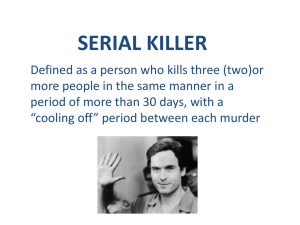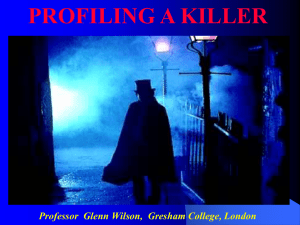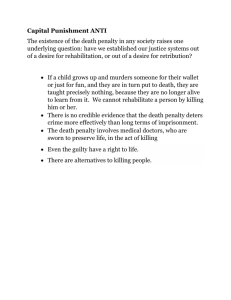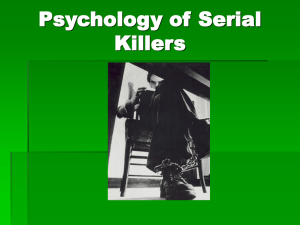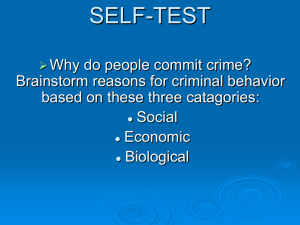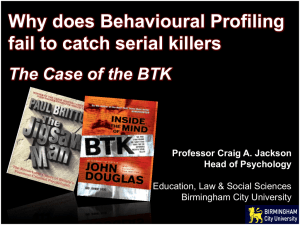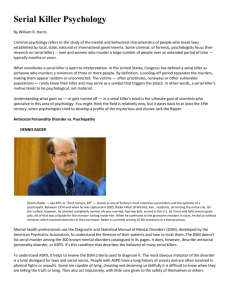SERIAL KILLERS: A DEADLY RAGE CRIME: A Smoldering Anger
advertisement
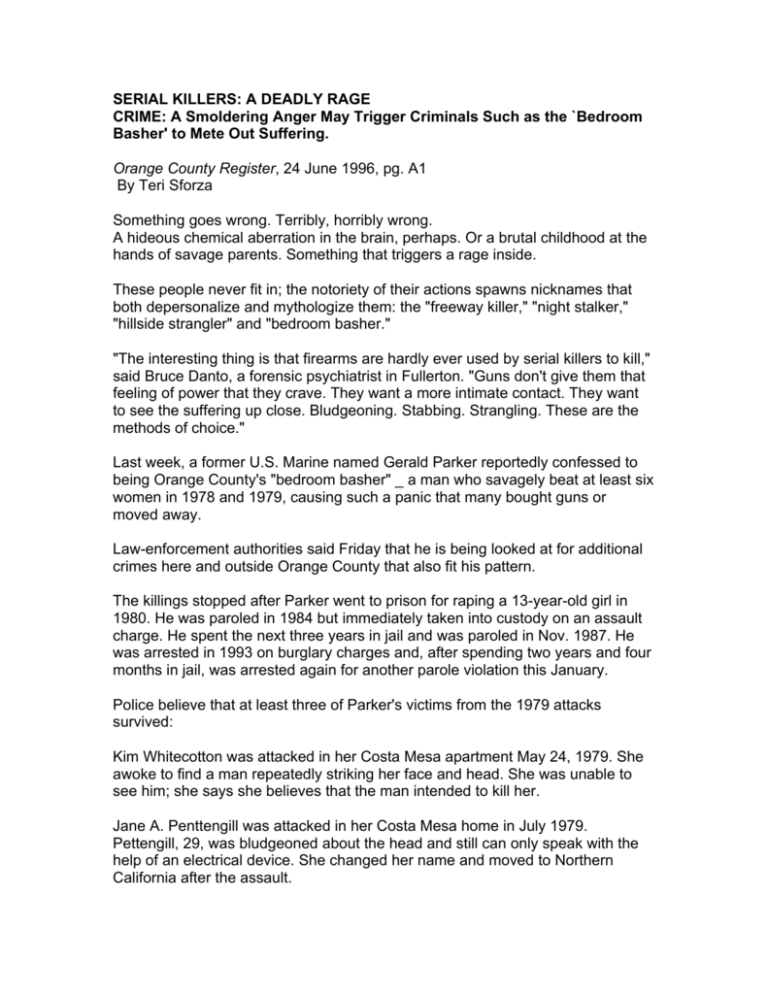
SERIAL KILLERS: A DEADLY RAGE CRIME: A Smoldering Anger May Trigger Criminals Such as the `Bedroom Basher' to Mete Out Suffering. Orange County Register, 24 June 1996, pg. A1 By Teri Sforza Something goes wrong. Terribly, horribly wrong. A hideous chemical aberration in the brain, perhaps. Or a brutal childhood at the hands of savage parents. Something that triggers a rage inside. These people never fit in; the notoriety of their actions spawns nicknames that both depersonalize and mythologize them: the "freeway killer," "night stalker," "hillside strangler" and "bedroom basher." "The interesting thing is that firearms are hardly ever used by serial killers to kill," said Bruce Danto, a forensic psychiatrist in Fullerton. "Guns don't give them that feeling of power that they crave. They want a more intimate contact. They want to see the suffering up close. Bludgeoning. Stabbing. Strangling. These are the methods of choice." Last week, a former U.S. Marine named Gerald Parker reportedly confessed to being Orange County's "bedroom basher" _ a man who savagely beat at least six women in 1978 and 1979, causing such a panic that many bought guns or moved away. Law-enforcement authorities said Friday that he is being looked at for additional crimes here and outside Orange County that also fit his pattern. The killings stopped after Parker went to prison for raping a 13-year-old girl in 1980. He was paroled in 1984 but immediately taken into custody on an assault charge. He spent the next three years in jail and was paroled in Nov. 1987. He was arrested in 1993 on burglary charges and, after spending two years and four months in jail, was arrested again for another parole violation this January. Police believe that at least three of Parker's victims from the 1979 attacks survived: Kim Whitecotton was attacked in her Costa Mesa apartment May 24, 1979. She awoke to find a man repeatedly striking her face and head. She was unable to see him; she says she believes that the man intended to kill her. Jane A. Penttengill was attacked in her Costa Mesa home in July 1979. Pettengill, 29, was bludgeoned about the head and still can only speak with the help of an electrical device. She changed her name and moved to Northern California after the assault. Dianna Green was nine months pregnant when Parker allegedly raped her and smashed her skull Sept. 30, 1979. Green's unborn daughter died. Green suffered brain damage. But she nonetheless accused her husband, Kevin, of the attack. On her testimony, an innocent man went to prison for 16 years. Kevin Lee Green was released Thursday when DNA evidence cleared him and linked Parker to the attack. Experts in the field are cautious in attempting to generalize about motive. "Be wary of anyone who says there's one cause behind serial killing: Every case is unique," said Michael Rustigan, a criminology professor at San Francisco State University. "What cuts through all these cases is rage _ rage against their own feelings of impotence and powerlessness, an early anger that's been smoldering for years. "With most serial sadistic lust killers, you can't find any medical defect. You can't find abnormal biochemistry or organic lesions or vitamin deficiencies. Most are as physically healthy as anybody else. What we find is that something's been festering. There's a lot of repressed hostility. Look at a gallery of (Ted) Bundy's victims, very much resembling the one woman who dumped him," Rustigan said. There are other common traits: Extreme narcissism. Monstrous egos. A lack of guilt feelings. "They feel no compassion," Rustigan said. "They blame the victim. It's always her fault: `The bitch wanted too much money.' What they've done is completely undermine their own moral responsibility. What's missing is conscience." Killers are often plagued by self-loathing as well, said Reid Meloy, a forensic psychologist in San Diego. "They often choose victims who reflect what they consider to be their own most disgusting characteristics. It's like a killing of the self," Meloy said. And perhaps the most simple, cliched, but true motivation: hatred of women. "There's a lot of data showing that these are misogynistic crimes," Meloy said. "The hatred is displaced from the original woman in every man's life: his mother. It sounds too Freudian and simplistic, but we have 50 years of cumulative data suggesting that's the case." That Dianna Green was raped in her ninth month of pregnancy _ and left for dead _ speaks volumes about the attacker's wrath toward women and motherhood, several experts said. Peek into the background of many serial killers and you'll see a baby who never bonded with his parents, Danto said. "There's no mother, no feeling of life or appreciation for love. They've never had it. And particularly for the males, there's no contact with the father, and no healthy social-sexual model. Dad is violent or not there at all. It's not difficult to see how these people come into being. The American family has been breaking down for years." Court documents show that Parker was one of eight children. His mother died when he was 8, and he was sent to live with his grandparents. Rustigan believes there are six kinds of serial killers: The "sadistic lust killer" (like Randy Kraft and Ted Bundy) “gets the most attention and adores the feelings of power and control that killing gives him.” "Thrill killers" enjoy terrorizing the community and lashing back at society. The "greed killer" wants money, like the landlady who murders her renters and then cashes their checks. At first, "pedophiliac killers" murder the children they have sex with, usually young boys, to get rid of the witnesses. Then they grow to enjoy killing as much as sex, as "freeway killer" William Bonin did. "Black widow serial killers" are often women who use poison to murder husbands or children, often for control or money. The Unabomber is an example of a "missionary serial killer" who murders for what he believes is a holy cause. The experts are divided on whet her there has been an increase in serial killers in the past three decades. Danto believes the surge in Southern California sociopaths in the late 1970s and early 1980s is linked to the closing of many mental-health hospitals during budgetary cutbacks. There is also disagreement on whether America is more prone to producing serial killers than other nations. Rustigan is convinced this is so. "America has about 5 percent of the world's population, and we produce 70 percent of the world's serial killers," Rustigan said. "England has certainly had its share, and Russia. But it's distinctively American, and it has a lot to do with the kind of extreme individualism we practice in America." In other nations, violence is collective: In Bosnia and Rwanda, it's tribe against tribe, clan against clan, Rustigan said. "Ours is much more the loner, the drifter, the wide-open society." Register staff writer Jonathan Volzke contributed to this stor y. RECENT SERIAL KILLERS IN CALIFORNIA Randy Kraft: Believed to have killed as many as 65 young men in Oregon, Michigan and California during a 13-year span that ended in 1983. Kraft was convicted of mutilating and murdering 16 young men in Orange County in 1988. Kraft is currently on death row in San Quentin prison. William George Bonin, aka the "freeway killer": Convicted of murdering 14 boys, four of them in Orange County. He lured them inside his green van and sexually assaulted and strangled them. Their nude bodies were often found face-down, their wrists still bound. Bonin was executed by lethal injection Feb. 23 at San Quentin prison. Richard Ramirez, aka the "night stalker": The tall, lanky drifter from El Paso, Texas, was convicted of 13 murders as part of a grisly rampage that terrorized Southern California and led to a nationwide hunt. Some of the assaults were tinged with satanic symbolism, such as pentagrams drawn on the body of one victim. Ramirez is on death row in San Quentin prison. Angelo Buono, left, and Kenneth Bianchi, aka the "hillside strangler": Between 1977 and 1978, the two men participated in the killing of 10 women in Los Angeles. Buono was convicted in nine of the killings and sentenced to life imprisonment; Bianchi, who testified against Buono, pleaded guilty to five murders, plus two others in the state of Washington. Buono is in Folsom prison serving a life sentence; Bianchi, who subsequently changed his name to Anthony A. Amato, is serving a life sentence in a Washington prison. Charles Manson: Manson and members of his notorious "family" are serving life terms in various prisons for at least 11 murders committed in the late 1960s. Manson is currently serving a life sentence in Corcoran state prison. IN UNITED STATES John Wayne Gacy Jr.: Convicted in 1980 of the sex slayings of 33 young men and boys. The victims' bodies were buried in a crawl space at Gacy's home near Chicago. Gacy was executed in 1994. David Berkowitz, aka "son of Sam": Terrorized New York City in 1976 and '77 by killing six people on the streets and in their cars. Currently in a New York prison serving a life sentence. Theodore Bundy: Convicted in 1979 of three murders, but police suspect Bundy of killing 36 women in six states before his apprehension in Florida. Bundy was executed in Florida in 1989. Jeffrey Dahmer: After police found body parts in Dahmer's Milwaukee apartment in 1991, he admitted killing 17 young men and boys, mutilating and sometimes cannibalizing his victims. Dahmer was killed by a fellow inmate in a Wisconsin prison in 1995. Joel Rifkin: The New York landscaper admitted strangling or suffocating 17 prostitutes over two years in 1994. He claims he dismembered two or three for easy disposal. Currently in prison in New York. ABROAD Rosemary West: Convicted in Great Britain in 1995 of torturing and killing 10 women and girls, including a daughter a! nd a stepdaughter.

